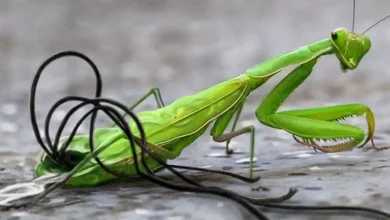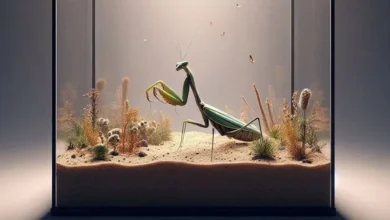Praying mantises are carnivorous insects that rely on a diet of live prey to thrive. The type of prey, feeding frequency, and dietary needs can vary depending on the species, size, and age of the mantis.
Providing a balanced and appropriate diet is essential for maintaining their health, growth, and reproductive success. In this guide, we’ll explore the dietary requirements for different mantis species, the types of prey they prefer, and best practices for feeding them in captivity.
Introduction to Mantis Dietary Needs

Praying mantises are obligate carnivores, meaning they must consume live prey to meet their nutritional needs. In the wild, mantises are opportunistic feeders, preying on a variety of insects and sometimes even small vertebrates. In captivity, their diet should mimic their natural feeding habits as closely as possible to ensure they receive all the necessary nutrients.
A well-balanced diet for mantises should include a variety of prey types, providing them with proteins, fats, and other essential nutrients. Feeding should be adjusted according to the mantis’s size, age, and species, with younger mantises (nymphs) requiring more frequent feedings than adults.
Common Types of Prey
There are several common types of prey that are suitable for feeding mantises in captivity. The choice of prey depends on the size and species of the mantis, as well as the availability of prey in your area.
Fruit Flies (Drosophila spp.)
- Best For: Young nymphs and smaller mantis species.
- Description: Fruit flies are a staple food for baby mantises and small species. They are easy to culture and provide a good source of nutrition.
- Feeding Tip: Ensure that the fruit flies are the appropriate size for your mantis. Drosophila melanogaster (flightless fruit flies) are commonly used for very small nymphs.
Crickets
- Best For: Medium to large mantises.
- Description: Crickets are widely available and provide a substantial meal for mantises. They are active, which stimulates the mantis’s hunting behavior.
- Feeding Tip: Crickets should be gut-loaded (fed a nutritious diet) before being offered to mantises to enhance their nutritional value.
Roaches
- Best For: Medium to large mantises.
- Description: Roaches, such as Dubia and Turkestan roaches, are an excellent source of nutrition for mantises. They are rich in protein and have a slower movement, making them easier for mantises to catch.
- Feeding Tip: Roaches are a good alternative to crickets and are less likely to escape or cause disturbances in the enclosure.
Moths and Butterflies
- Best For: Species that naturally prey on flying insects.
- Description: Moths and butterflies are a natural prey item for many mantis species, particularly those that specialize in hunting flying insects. They provide variety in the mantis’s diet.
- Feeding Tip: Offering live moths or butterflies encourages natural hunting behavior. Ensure that they are free from pesticides.
Flies
- Best For: Most mantis species.
- Description: Flies are highly active prey and are readily accepted by mantises. House flies (Musca domestica) and blue bottle flies (Calliphora vomitoria) are commonly used.
- Feeding Tip: Flies should be fed nutritious foods before being offered to mantises. They can be bought as maggots and then allowed to pupate and emerge as flies.
Mealworms and Waxworms
- Best For: Occasional feeding for larger mantises.
- Description: Mealworms and waxworms can be used as supplementary food. However, they are high in fat and should not be the mainstay of a mantis’s diet.
- Feeding Tip: Offer mealworms and waxworms sparingly to avoid obesity and nutritional imbalances.
Species-Specific Diet Recommendations
Different mantis species have varying dietary preferences and needs based on their size, natural habitat, and hunting behaviors.
Orchid Mantis (Hymenopus coronatus)
- Preferred Prey: Small flies, moths, butterflies, and other flying insects.
- Diet: The Orchid Mantis thrives on a diet of small, active prey. They prefer flying insects, which they naturally ambush in the wild. Fruit flies are ideal for young nymphs, while house flies and small moths are suitable for adults.
- Feeding Frequency: Feed nymphs daily and adults every 2-3 days.
Ghost Mantis (Phyllocrania paradoxa)
- Preferred Prey: Small to medium-sized insects like flies, small crickets, and roaches.
- Diet: The Ghost Mantis has a slower metabolism and does not require as much food as more active species. They can be fed small crickets, flies, or roaches.
- Feeding Frequency: Feed every 3-4 days, adjusting based on the mantis’s appetite and growth stage.
Chinese Mantis (Tenodera sinensis)
- Preferred Prey: Larger insects like crickets, grasshoppers, roaches, and moths.
- Diet: The Chinese Mantis is a voracious eater, capable of taking down larger prey. Offer a variety of insects such as crickets, roaches, and moths. Larger nymphs and adults can handle prey almost half their size.
- Feeding Frequency: Feed nymphs every 1-2 days and adults every 2-3 days.
Giant African Mantis (Sphodromantis lineola)
- Preferred Prey: Large insects like crickets, roaches, and the occasional small vertebrate (in the wild).
- Diet: The Giant African Mantis has a strong appetite and can be fed larger prey such as crickets, roaches, and occasionally waxworms. Variety is key to ensuring a balanced diet.
- Feeding Frequency: Feed nymphs daily and adults every 2-3 days.
Feeding Techniques and Best Practices
Feeding mantises involves more than just providing food; it’s about ensuring the prey is appropriate in size, nutritious, and offered in a way that stimulates natural hunting behaviors.
Feeding Frequency and Portion Sizes
- Nymphs: Younger mantises (nymphs) have faster metabolisms and require more frequent feeding. Offer food daily or every other day, ensuring the prey is appropriately sized.
- Adults: Adult mantises can be fed less frequently, typically every 2-3 days. Larger prey items or multiple smaller ones can be offered depending on the mantis’s size and appetite.
- Portion Control: The prey should generally be no larger than half the size of the mantis to avoid injury or difficulty during feeding. Overfeeding can lead to obesity and molting issues.
Introducing Prey to the Enclosure
- Timing: It’s best to introduce prey when the mantis is active, typically during daylight hours. Ensure the mantis is not in the middle of molting, as this can stress or harm the insect.
- Release Method: Release the prey near the mantis or in a location where the mantis can see and easily capture it. Ensure that the prey cannot escape the enclosure, as this could lead to it hiding or causing stress to the mantis.
- Observation: Watch the feeding process to ensure the mantis captures the prey. If the mantis shows no interest after a few hours, remove the prey to prevent it from disturbing or harming the mantis.
Avoiding Overfeeding and Food Waste
- Monitor Appetite: Pay attention to your mantis’s feeding habits. If it consistently leaves food uneaten, reduce the quantity or frequency of feeding.
- Remove Uneaten Prey: Any uneaten prey should be removed from the enclosure to prevent it from stressing or injuring the mantis, especially during molting.
- Adjust Based on Behavior: If your mantis becomes lethargic or appears overweight, consider reducing the amount of food offered. Conversely, if it appears underweight or is consistently hungry, slightly increase the feeding frequency.
Supplements and Nutritional Considerations
While mantises typically receive all their nutrients from live prey, there are some considerations for ensuring they have a balanced diet.
- Gut-Loading Prey: Ensure that prey items like crickets and roaches are gut-loaded with nutritious foods before being fed to your mantis. This means feeding the prey a healthy diet of fruits, vegetables, and high-quality insect food for at least 24 hours before offering them to your mantis.
- Calcium Supplementation: While not usually necessary, dusting prey with a light calcium supplement can be beneficial, especially if you’re concerned about nutritional deficiencies. However, this should be done sparingly to avoid over-supplementation.
- Diversity in Diet: Offering a variety of prey ensures that your mantis receives a broad range of nutrients. Rotate between different prey types like flies, crickets, and moths to provide a balanced diet.
Common Feeding Challenges and Solutions
Feeding mantises can sometimes present challenges, such as reluctance to eat or issues with molting. Here are some common problems and their solutions:
- Reluctance to Eat: If your mantis is not eating, check the environmental conditions. Ensure the temperature and humidity are within the optimal range. Also, try offering a different type of prey to stimulate its appetite.
- Molting Issues: Overfeeding can cause issues during molting, as a mantis that is too heavy may struggle to shed its exoskeleton. Ensure you are not overfeeding, especially as the mantis approaches a molt.
- Prey Too Large: Offering prey that is too large can lead to injury or stress. Always choose prey that is no larger than half the size of your mantis.
Feeding mantises a proper diet is essential for their health, growth, and well-being. By understanding the specific dietary needs of different mantis species and providing a varied and balanced diet, you can ensure your mantis thrives in captivity. Whether you’re caring for a delicate Orchid Mantis or a robust Giant African Mantis, following these guidelines will help you meet their nutritional needs and enjoy watching their fascinating predatory behavior.


